How do smart watches, sports trackers and other gadgets measure the pulse? Part 1
Hello!

There is very little time left before the start of our crowdfunding company for measuring EMVIO stress levels . A short respite appeared and fingers asked for the keyboard.
At the very initial stage of development, we conducted a small analytical review of methods for measuring a person’s pulse and periodically updated it with new projects. I wanted to share this information with the community. We hope that it will be interesting to a wide circle of readers and give an idea of the state of technology in this area.
In this review, the emphasis is precisely on the use of pulse measurement methods in gadgets such as "for fan". Some methods are already implemented in finished mass products, while others are waiting in the wings. But first, a few words about what we are actually measuring and why it is important.
As you know, the heart is an autonomous muscle organ that performs a pumping function, providing a continuous flow of blood in the blood vessels through rhythmic contractions. In the heart there is a section in which the impulses responsible for the contraction of muscle fibers are generated, the so-called pacemaker. In the normal state, in the absence of pathologies, this site completely determines the heart rate. As a result, the heart cycle is formed - a sequence of contractions (systole) and relaxation (diastole) of the heart muscles, starting from the atria and ending with the ventricles. In the general case, pulse means the frequency with which the heart cycle repeats. However, there are nuances in which way we register this frequency.
In those days when medicine did not have the technical means of diagnostics, the pulse was measured by all known methods - by palpation, i.e. they applied a finger to a specific area of the body and listened to their tactile sensations, and counted the number of shocks of the artery wall through the skin over a period of time — usually 30 seconds or one minute. Hence the Latin name for this effect - pulsus, i.e. beat, respectively, unit: beats per minute, beatsperminute (bpm). There are many palpation techniques, the most famous of which are palpation of the pulse on the wrist and neck, in the region of the carotid artery, which is so popular in the cinema.
In electrocardiography, the pulse is calculated by the signal of the electrical activity of the heart - the electrocardiogram (EX) by measuring the duration of the interval (in seconds) between adjacent R EX teeth, followed by conversion to beats per minute according to a simple formula: BPM = 60 / (RR interval) . Accordingly, you need to remember that this is a ventricular pulse, because the atrial reduction period (PP interval) may vary slightly.
Attention !!!Immediately we want to note an important point that confuses terminology and is often found in comments on articles about gadgets with heart rate measurement. In fact, the pulse, which is measured by the contractions of the walls of the blood vessels, and the pulse, which is measured by the electrical activity of the heart, have a different physiological nature, a different shape of the time curve, a different phase shift and accordingly require different registration methods and processing algorithms. Therefore, there can be no RR intervals when measuring a pulse by modulating the volume of blood supply to arteries and capillaries and mechanical vibrations of their walls. And vice versa, it cannot be said that if you do not have RR intervals, then you cannot measure intervals similar in physiological significance to a pulse wave.
So, here is our review of the most common methods for measuring heart rate and examples of gadgets that implement them.
After the electrical activity of the heart was discovered at the end of the 19th century, it was technically possible to register it. The first, in fact, was done by Willem Einthoven in 1902, using his megadevice - a string galvanometer. By the way, he carried out the transmission of ECG via telephone cable from the hospital to the laboratory and, in fact, realized the idea of remote access to medical data!

Three cans with “brine” and an electrocardiograph weighing 270 kg! This is how the method was born that today helps millions of people around the world.
For his work in 1924, he became a Nobel laureate. It was Einthoven who first received a real electrocardiogram (he invented the name himself), developed the lead system - Einthoven's triangle, and introduced the names of the EX segments. The most famous is the QRS complex - the moment of electrical excitation of the ventricles and, as the element of this complex most pronounced in its temporal and frequency properties, the R

wave. Painfully familiar signal and RR interval!
In modern clinical practice, various lead systems are used for recording ECS: leads from the limbs, chest leads in various configurations, orthogonal leads (according to Frank), etc. From the point of view of measuring the pulse, you can use any leads, because in a normal EX R, the tooth in one form or another is present on all leads.
When designing wearable gadgets and various sports simulators, the lead system was simplified to two electrode points. The most famous option for implementing this approach are sports chest monitors in the form of a cardiomonitor strap - HRM strap or HRM band. We think readers leading a sporting lifestyle already have such devices.

An example of the design of the strap and Mr. Gadget 80 lvl. Sensor pad is two ECG electrodes from different sides of the chest.
In the market, HRM straps by Garmin and Polar are popular, and there are also many Chinese clones. In such straps, the electrodes are made in the form of two strips of conductive material. The strap can be part of the entire device or fastened to it with clip fasteners. Heart rate values are usually transmitted via Bluetooth via ANT + or Smart to a sports watch or smartphone. It is quite convenient for sports, but constant wearing causes discomfort.
We experimented with such straps in terms of the possibility of assessing heart rate variability, considering them to be the standard, but the data coming from them turned out to be very smooth. Member of our team Kvanto25 published posthow he dealt with the protocol of the Polar strap and connected it to the computer through the Labview environment.
The next embodiment of two electrode systems is the separation of the electrodes into two hands, but without the constant connection of one of them. In such devices, one electrode is fixed to the wrist in the form of the back wall of a watch or bracelet, and the other is carried out on the front of the device. To measure the pulse, you need to touch the front electrode with your free hand and wait a few seconds.
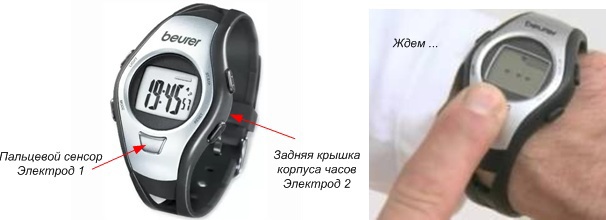
An example of a front electrode heart rate monitor (Beurer heart rate monitor)
An interesting device using this technology is the Phyode W / Me bracelet, whose developers conducted a successful Kickstarter campaign, and their product is commercially available. On a habr there was a post about him .
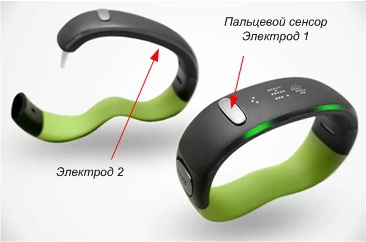
PhyodeW / Me electrode system
The upper electrode is aligned with the button, so many people, looking at the device from the pictures and reading the reviews, thought that the measurement was just at the touch of a button. Now you know that on such bracelets continuous registration with free hands is in principle not possible.
The advantage of this device is that measuring your heart rate is not the main goal. The bracelet is positioned as a means of conducting and monitoring breathing techniques, such as an individual trainer. We acquired Phyode and lost with it. Everything works as promised, a real ECG is recorded, corresponding to the classic first lead of the ECG. However, the device is very sensitive to finger movements on the front electrode, slightly shifted and the signal floated. Given the fact that for the collection of statistics it takes about three minutes, the registration process looks stressful.
Here is another option for using the two-hand principle in the FlyShark Smartwatch project, which is posted on Kickstarter .
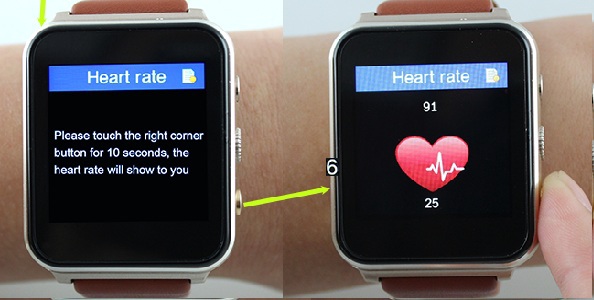
Heart rate registration in the FlyShark Smartwatch project. Please hold a finger.
What else is new in this area? Be sure to mention the interesting implementation of the ECG electrode - a capacitive electric field sensor EPIC Ultra High Impedance ECG Sensor manufactured by Plessey Semiconductors.
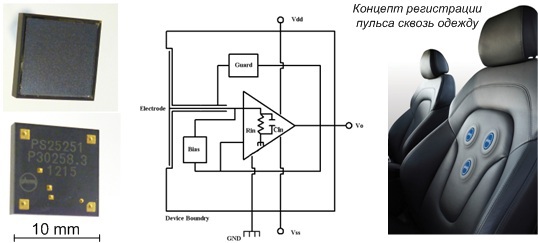
Capacitive EPIC sensor for non-contact ECG recording.
A primary amplifier is installed inside the sensor, so it can be considered active. The sensor is quite compact (10x10 mm), does not require direct electrical contact, respectively, has no polarization effects and does not need to be wetted. We think this solution is very promising for gadgets with the registration of EX. We have not yet seen any finished devices on these sensors.
Truly the most common way to measure heart rate in the clinic and at home! Hundreds of different devices from clothespins to rings. The plethysmography method itself is based on recording changes in the volume of blood supply to the organ. The result of this registration will be a pulse wave. The clinical possibilities of plethysmography go far beyond the simple definition of a pulse, but in this case we are interested in it.
Pulse determination based on plethysmography can be implemented in two main ways: impedance and optical. There is a third option - mechanical, but we will not consider it.
As the Medical Dictionary tells us, impedance plethysmography is a method for recording and studying pulse fluctuations in the blood supply of blood vessels of various organs and tissues, based on recording changes in the total (ohmic and capacitive) electrical resistance to high-frequency alternating current. In Russia, the term rheography is often used. This registration method dates back to the research of the scientist Mann (Mann, 30s) and domestic researcher A. Kedrov. (40s).
Currently, the methodology of the method is based on a two or four-point scheme for measuring volume resistivity and consists in the following: a signal with a frequency of 20 to 150 kHz (depending on the tissues being studied) is passed through the organ under investigation using two electrodes.

Electrode system of impedance plethysmography. The picture from here.
The main condition for the signal generator is the constancy of current; its value is usually chosen no more than 10-15 μA. When a signal passes through a tissue, its amplitude is modulated by a change in blood supply. The second electrode system removes the modulated signal, in fact, we have the circuit of the impedance-voltage converter. In a two-point circuit, the electrodes of the generator and receiver are combined. Further, the signal is amplified, the carrier frequency is removed from it, the constant component is eliminated, and the delta we need remains.
If you calibrate the device (this is a prerequisite for the clinic), then in the Y axis you can postpone the values in Ohms. The result is such a signal.

Examples of temporary ECG curves, impedance plethysmograms (rheograms) and its derivative with synchronous recording. ( from here )
A very revealing picture. Pay attention to where the RR-interval on the ECS is, and where the distance between the vertices corresponding to the duration of the cardiac cycle on the rheogram. Also pay attention to the sharp front of the R wave and the gentle front of the systolic phase of the rheogram.
From the pulse curve, you can get quite a lot of information on the state of blood circulation of the organ under study, especially synchronously with the ECG, but we only need the pulse. It is not difficult to determine it - you need to find two local maximums corresponding to the maximum amplitude of the systolic wave, calculate the delta in seconds ΔT and then BMP = 60 / ΔT .
We have not yet found any examples of gadgets that use this method. But there is an example of the concept of an implantable sensor for controlling blood circulation in an artery. Here is an article about him. The active sensor lands directly on the artery, communicates with the host device via inductive communication. We believe that this is a very interesting and promising approach. The principle of operation is clear from the picture. The match is shown for understanding the size :) A 4-point registration scheme and a flexible printed circuit board are used. I think, if you wish, you can finish the idea for a wearable micro-gadget. The advantage of this solution is that the consumption of such a sensor is vanishingly small.
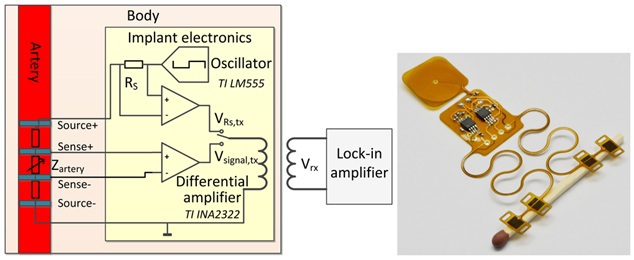
Implantable blood and pulse sensor. Looks like a Johnny Mnemonic accessory.
At the end of this section we make a remark. At one time, we believed that in this way the pulse was measured in the famous HealBeGo startup, because in this device the basic functionality is implemented by impedance spectroscopy, which, in essence, is rheography, only with a variable frequency of the probe signal. In general, everything is already on board. However, according to the description of the characteristics of the device, the pulse in HealBe is measured mechanically using a piezoelectric sensor (about this method in the second part of the review).
Optical is the most common way to measure your heart rate in terms of mass use. The narrowing and expansion of the vessel under the influence of arterial pulsation of blood flow cause a corresponding change in the amplitude of the signal received from the output of the photodetector. The very first devices were used in the clinic and measured the pulse from the finger in the mode of lumen or reflection. The shape of the pulse curve repeats the rheogram.

Illustration of the principle of photoplethysmography.
The method was widely used in the clinic and soon the technology was applied in household devices. For example, in compact pulse oximeters that record the pulse and oxygen saturation of blood in the capillaries of the finger. Hundreds of modifications are made in the world. For the home, for the family, it’s quite suitable, but not suitable for constant wear.
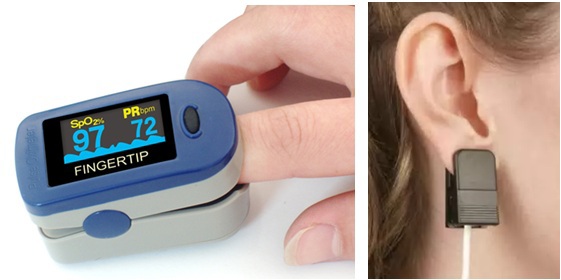
Pulse oximeter and ear clip. Thousands of them!
There are options with ear clips and headphones with integrated sensors. For example, such an option from Jabra or the new project Glow Headphones . The functionality is similar to HRM straps, but more stylish design, familiar device, free hands. You won’t be wearing earplugs all the time, but just for jogging in the fresh air to the music.
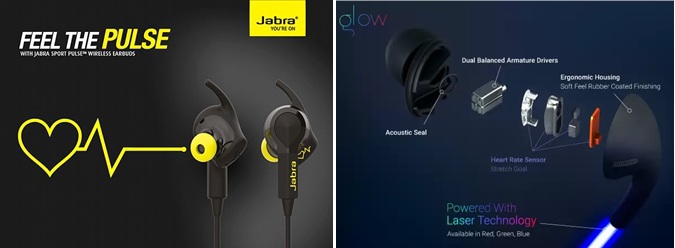
Jabra Sport Pulse ™ Wireless and Glow Headphones. The pulse is recorded by the in-ear (in-ear sensor) method.
Breakthrough
The most tempting was to measure the pulse from the wrist, because it is such a familiar and comfortable place. The first was a Mio Alpha watch with a successful company on Kickstarter.
The creator of the product, Liz Dickinson, pathetically proclaimed this device the Holy Grail of heart rate measurement. The sensor module was developed by the guys from Philips. Today it is the highest quality device for continuous measurement of heart rate from the wrist using photoplethysmography.
Further to the world there are such worthy things as Basis B1, Samsung Galaxy Gear and Gear Fit, Moto 360 and of course expected by all fans of AppleWatch apple brands.
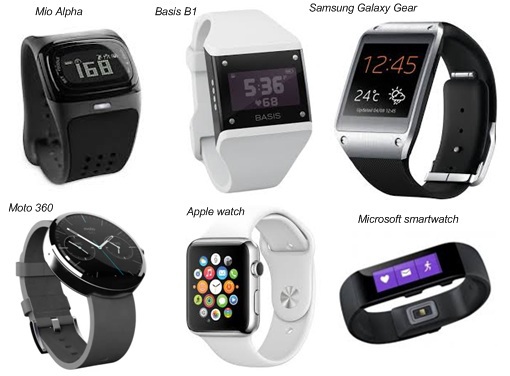
Give a lot of smart watches and different!
Now we can say that the technology has been developed and introduced into mass production. In all such devices, the measurement of the pulse by the reflected signal is implemented.
Emitter Wavelength Selection
Now a few words, how to choose the wavelength of the emitter. It all depends on the task at hand. The rationale for the choice is well illustrated by the graph of light absorption of oxy and deoxyhemoglobin with superimposed curves of the spectral characteristics of the emitters.
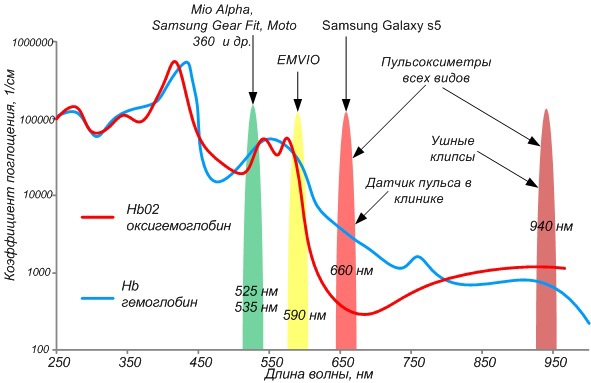
The hemoglobin light absorption curve and the main emission spectra of pulse photoplethysmographic sensors.
The choice of wavelength depends on what we want to measure the pulse and / or saturation of blood oxygen saturation SO2.
Just a pulse. For this case, the region where the absorption is maximum is important - this is a range from 500 to 600 nm, not counting the maximum in the ultraviolet part. Usually, a value of 525 nm (green) or with a small offset of 535 nm is used (used in the OSRAM SFH 7050 - Photoplethysmography Sensor).

The green LED of the heart rate sensor is the most popular option in smart watches and bracelets. The sensor of the Samsung Galaxy S5 smartphone uses a red LED.
Oximetry. In this mode, it is necessary to measure the pulse and evaluate blood saturation with oxygen. The method is based on the difference in the absorption of hemoglobin bound (oxy) and oxygen not bound to (deoxy) oxygen. The maximum absorption of deoxygenated hemoglobin (Hb) is in the “red” (660 nm) range; the maximum absorption of oxygenated (Hb02) hemoglobin is in the infrared (940 nm). To calculate the pulse, a channel with a wavelength of 660 nm is used.
Yellow for EMVIO.For our EMVIO instrument, we chose from two ranges: 525 nm and 590 nm (yellow). In this case, we took into account the maximum spectral sensitivity of our optical sensor. The experiments showed that there is practically no difference between them (within the framework of our design and the selected sensor). Any difference is interrupted by motion artifacts, the individual properties of the skin, the thickness of the subcutaneous layer of the wrist, and the degree to which the sensor is pressed against the skin. We wanted to somehow stand out from the general “green” list and so far dwelled on yellow.
Of course, measurements can be made not only from the wrist. There are non-standard options on the market for choosing a pulse registration point. For example, from the forehead. This approach was used in the project of a smart helmet for cyclists. Life beam Smart helmetdeveloped by the Israeli company Lifebeam. In the proposals of this company there are also baseball caps and sun visors for girls. If you wear a baseball cap all the time, then this is your option.

The cyclist is pleased that there is no need to wear an HRM strap.
In general, the choice of registration points is quite large: wrist, finger, earlobe, forehead, arm bicep, ankle and foot for kids. Full expanse for developers.
A big plus of the optical method is the ease of implementation on modern smartphones, where a standard video camera is used as a sensor, and a flash LED is used as a radiator. In the new Samsung Galaxy S5 smartphone on the back of the case, for the convenience of the user, there is already a standard heart rate sensor module, it is possible other manufacturers will introduce similar solutions. This can be decisive for devices in which there is no continuous registration, smartphones will absorb their functionality.
New horizons of photoplethysmography
Further development of this method is associated with a rethinking of the functionality of the optical sensor and the technological capabilities of modern wearable devices in terms of real-time video processing. As a result, we have the idea of measuring the pulse from the video image of the face. Backlight is natural light.
An original solution, given that the camcorder is a standard attribute of any laptop, smartphone and even smart watch. The idea of the method is disclosed in this work .
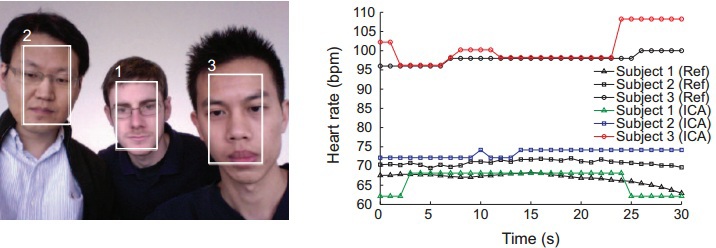
Subject N3 is clearly tense - the pulse at 100 beats / min, probably gives work to his leader Subject N2. Subject N1 just passed by.
First, fragments of the face are highlighted on the frames, then the image is decomposed into three color channels and expanded on a time scale (RGB trace). Pulse wave extraction is based on the decomposition of the image by the analysis of independent components (ICA) and the selection of the frequency component associated with the modulation of pixel brightness under the influence of blood pulsation.
Philips Innovation Lab has implemented a similar approach in the form of Vital Signs Camera for IPhone. A very interesting thing. The averaging of values is certainly large, but in principle the method works. A similar project is being developed by Fujitsu Laboratories .
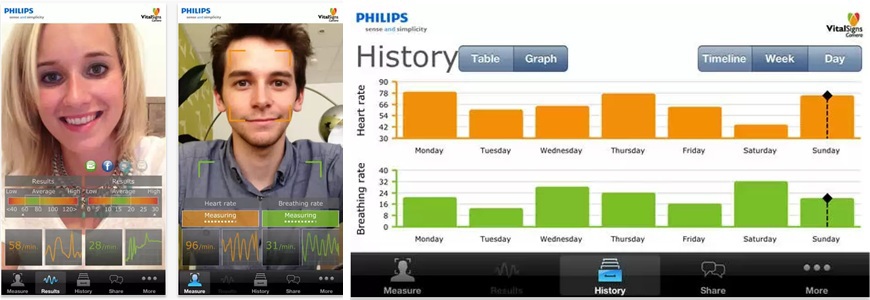
Screen Views of Vital Signs Camera.
So in the future, video surveillance systems will be able to remotely measure your heart rate. The NSA office will rejoice.
The review ends in the next post “ How do smart watches, sports trackers and other gadgets measure heart rate? Part 2 ". In that part, we will talk about more exotic methods of registering a pulse, which are used in modern gadgets.
Good luck And once again, we invite you to the site of our EMVIO project .

There is very little time left before the start of our crowdfunding company for measuring EMVIO stress levels . A short respite appeared and fingers asked for the keyboard.
At the very initial stage of development, we conducted a small analytical review of methods for measuring a person’s pulse and periodically updated it with new projects. I wanted to share this information with the community. We hope that it will be interesting to a wide circle of readers and give an idea of the state of technology in this area.
In this review, the emphasis is precisely on the use of pulse measurement methods in gadgets such as "for fan". Some methods are already implemented in finished mass products, while others are waiting in the wings. But first, a few words about what we are actually measuring and why it is important.
Little bit about our heart
As you know, the heart is an autonomous muscle organ that performs a pumping function, providing a continuous flow of blood in the blood vessels through rhythmic contractions. In the heart there is a section in which the impulses responsible for the contraction of muscle fibers are generated, the so-called pacemaker. In the normal state, in the absence of pathologies, this site completely determines the heart rate. As a result, the heart cycle is formed - a sequence of contractions (systole) and relaxation (diastole) of the heart muscles, starting from the atria and ending with the ventricles. In the general case, pulse means the frequency with which the heart cycle repeats. However, there are nuances in which way we register this frequency.
What do we take as a pulse
In those days when medicine did not have the technical means of diagnostics, the pulse was measured by all known methods - by palpation, i.e. they applied a finger to a specific area of the body and listened to their tactile sensations, and counted the number of shocks of the artery wall through the skin over a period of time — usually 30 seconds or one minute. Hence the Latin name for this effect - pulsus, i.e. beat, respectively, unit: beats per minute, beatsperminute (bpm). There are many palpation techniques, the most famous of which are palpation of the pulse on the wrist and neck, in the region of the carotid artery, which is so popular in the cinema.
In electrocardiography, the pulse is calculated by the signal of the electrical activity of the heart - the electrocardiogram (EX) by measuring the duration of the interval (in seconds) between adjacent R EX teeth, followed by conversion to beats per minute according to a simple formula: BPM = 60 / (RR interval) . Accordingly, you need to remember that this is a ventricular pulse, because the atrial reduction period (PP interval) may vary slightly.
Attention !!!Immediately we want to note an important point that confuses terminology and is often found in comments on articles about gadgets with heart rate measurement. In fact, the pulse, which is measured by the contractions of the walls of the blood vessels, and the pulse, which is measured by the electrical activity of the heart, have a different physiological nature, a different shape of the time curve, a different phase shift and accordingly require different registration methods and processing algorithms. Therefore, there can be no RR intervals when measuring a pulse by modulating the volume of blood supply to arteries and capillaries and mechanical vibrations of their walls. And vice versa, it cannot be said that if you do not have RR intervals, then you cannot measure intervals similar in physiological significance to a pulse wave.
How do gadgets measure heart rate?
So, here is our review of the most common methods for measuring heart rate and examples of gadgets that implement them.
1. Measurement of heart rate by electrocardiogram
After the electrical activity of the heart was discovered at the end of the 19th century, it was technically possible to register it. The first, in fact, was done by Willem Einthoven in 1902, using his megadevice - a string galvanometer. By the way, he carried out the transmission of ECG via telephone cable from the hospital to the laboratory and, in fact, realized the idea of remote access to medical data!

Three cans with “brine” and an electrocardiograph weighing 270 kg! This is how the method was born that today helps millions of people around the world.
For his work in 1924, he became a Nobel laureate. It was Einthoven who first received a real electrocardiogram (he invented the name himself), developed the lead system - Einthoven's triangle, and introduced the names of the EX segments. The most famous is the QRS complex - the moment of electrical excitation of the ventricles and, as the element of this complex most pronounced in its temporal and frequency properties, the R

wave. Painfully familiar signal and RR interval!
In modern clinical practice, various lead systems are used for recording ECS: leads from the limbs, chest leads in various configurations, orthogonal leads (according to Frank), etc. From the point of view of measuring the pulse, you can use any leads, because in a normal EX R, the tooth in one form or another is present on all leads.
Sports chest heart rate sensors
When designing wearable gadgets and various sports simulators, the lead system was simplified to two electrode points. The most famous option for implementing this approach are sports chest monitors in the form of a cardiomonitor strap - HRM strap or HRM band. We think readers leading a sporting lifestyle already have such devices.

An example of the design of the strap and Mr. Gadget 80 lvl. Sensor pad is two ECG electrodes from different sides of the chest.
In the market, HRM straps by Garmin and Polar are popular, and there are also many Chinese clones. In such straps, the electrodes are made in the form of two strips of conductive material. The strap can be part of the entire device or fastened to it with clip fasteners. Heart rate values are usually transmitted via Bluetooth via ANT + or Smart to a sports watch or smartphone. It is quite convenient for sports, but constant wearing causes discomfort.
We experimented with such straps in terms of the possibility of assessing heart rate variability, considering them to be the standard, but the data coming from them turned out to be very smooth. Member of our team Kvanto25 published posthow he dealt with the protocol of the Polar strap and connected it to the computer through the Labview environment.
With two hands
The next embodiment of two electrode systems is the separation of the electrodes into two hands, but without the constant connection of one of them. In such devices, one electrode is fixed to the wrist in the form of the back wall of a watch or bracelet, and the other is carried out on the front of the device. To measure the pulse, you need to touch the front electrode with your free hand and wait a few seconds.

An example of a front electrode heart rate monitor (Beurer heart rate monitor)
An interesting device using this technology is the Phyode W / Me bracelet, whose developers conducted a successful Kickstarter campaign, and their product is commercially available. On a habr there was a post about him .

PhyodeW / Me electrode system
The upper electrode is aligned with the button, so many people, looking at the device from the pictures and reading the reviews, thought that the measurement was just at the touch of a button. Now you know that on such bracelets continuous registration with free hands is in principle not possible.
The advantage of this device is that measuring your heart rate is not the main goal. The bracelet is positioned as a means of conducting and monitoring breathing techniques, such as an individual trainer. We acquired Phyode and lost with it. Everything works as promised, a real ECG is recorded, corresponding to the classic first lead of the ECG. However, the device is very sensitive to finger movements on the front electrode, slightly shifted and the signal floated. Given the fact that for the collection of statistics it takes about three minutes, the registration process looks stressful.
Here is another option for using the two-hand principle in the FlyShark Smartwatch project, which is posted on Kickstarter .

Heart rate registration in the FlyShark Smartwatch project. Please hold a finger.
What else is new in this area? Be sure to mention the interesting implementation of the ECG electrode - a capacitive electric field sensor EPIC Ultra High Impedance ECG Sensor manufactured by Plessey Semiconductors.

Capacitive EPIC sensor for non-contact ECG recording.
A primary amplifier is installed inside the sensor, so it can be considered active. The sensor is quite compact (10x10 mm), does not require direct electrical contact, respectively, has no polarization effects and does not need to be wetted. We think this solution is very promising for gadgets with the registration of EX. We have not yet seen any finished devices on these sensors.
2. Pulse measurement based on plethysmography
Truly the most common way to measure heart rate in the clinic and at home! Hundreds of different devices from clothespins to rings. The plethysmography method itself is based on recording changes in the volume of blood supply to the organ. The result of this registration will be a pulse wave. The clinical possibilities of plethysmography go far beyond the simple definition of a pulse, but in this case we are interested in it.
Pulse determination based on plethysmography can be implemented in two main ways: impedance and optical. There is a third option - mechanical, but we will not consider it.
Impedance plethysmography
As the Medical Dictionary tells us, impedance plethysmography is a method for recording and studying pulse fluctuations in the blood supply of blood vessels of various organs and tissues, based on recording changes in the total (ohmic and capacitive) electrical resistance to high-frequency alternating current. In Russia, the term rheography is often used. This registration method dates back to the research of the scientist Mann (Mann, 30s) and domestic researcher A. Kedrov. (40s).
Currently, the methodology of the method is based on a two or four-point scheme for measuring volume resistivity and consists in the following: a signal with a frequency of 20 to 150 kHz (depending on the tissues being studied) is passed through the organ under investigation using two electrodes.

Electrode system of impedance plethysmography. The picture from here.
The main condition for the signal generator is the constancy of current; its value is usually chosen no more than 10-15 μA. When a signal passes through a tissue, its amplitude is modulated by a change in blood supply. The second electrode system removes the modulated signal, in fact, we have the circuit of the impedance-voltage converter. In a two-point circuit, the electrodes of the generator and receiver are combined. Further, the signal is amplified, the carrier frequency is removed from it, the constant component is eliminated, and the delta we need remains.
If you calibrate the device (this is a prerequisite for the clinic), then in the Y axis you can postpone the values in Ohms. The result is such a signal.

Examples of temporary ECG curves, impedance plethysmograms (rheograms) and its derivative with synchronous recording. ( from here )
A very revealing picture. Pay attention to where the RR-interval on the ECS is, and where the distance between the vertices corresponding to the duration of the cardiac cycle on the rheogram. Also pay attention to the sharp front of the R wave and the gentle front of the systolic phase of the rheogram.
From the pulse curve, you can get quite a lot of information on the state of blood circulation of the organ under study, especially synchronously with the ECG, but we only need the pulse. It is not difficult to determine it - you need to find two local maximums corresponding to the maximum amplitude of the systolic wave, calculate the delta in seconds ΔT and then BMP = 60 / ΔT .
We have not yet found any examples of gadgets that use this method. But there is an example of the concept of an implantable sensor for controlling blood circulation in an artery. Here is an article about him. The active sensor lands directly on the artery, communicates with the host device via inductive communication. We believe that this is a very interesting and promising approach. The principle of operation is clear from the picture. The match is shown for understanding the size :) A 4-point registration scheme and a flexible printed circuit board are used. I think, if you wish, you can finish the idea for a wearable micro-gadget. The advantage of this solution is that the consumption of such a sensor is vanishingly small.

Implantable blood and pulse sensor. Looks like a Johnny Mnemonic accessory.
At the end of this section we make a remark. At one time, we believed that in this way the pulse was measured in the famous HealBeGo startup, because in this device the basic functionality is implemented by impedance spectroscopy, which, in essence, is rheography, only with a variable frequency of the probe signal. In general, everything is already on board. However, according to the description of the characteristics of the device, the pulse in HealBe is measured mechanically using a piezoelectric sensor (about this method in the second part of the review).
Optical plethysmography or photoplethysmography
Optical is the most common way to measure your heart rate in terms of mass use. The narrowing and expansion of the vessel under the influence of arterial pulsation of blood flow cause a corresponding change in the amplitude of the signal received from the output of the photodetector. The very first devices were used in the clinic and measured the pulse from the finger in the mode of lumen or reflection. The shape of the pulse curve repeats the rheogram.

Illustration of the principle of photoplethysmography.
The method was widely used in the clinic and soon the technology was applied in household devices. For example, in compact pulse oximeters that record the pulse and oxygen saturation of blood in the capillaries of the finger. Hundreds of modifications are made in the world. For the home, for the family, it’s quite suitable, but not suitable for constant wear.

Pulse oximeter and ear clip. Thousands of them!
There are options with ear clips and headphones with integrated sensors. For example, such an option from Jabra or the new project Glow Headphones . The functionality is similar to HRM straps, but more stylish design, familiar device, free hands. You won’t be wearing earplugs all the time, but just for jogging in the fresh air to the music.

Jabra Sport Pulse ™ Wireless and Glow Headphones. The pulse is recorded by the in-ear (in-ear sensor) method.
Breakthrough
The most tempting was to measure the pulse from the wrist, because it is such a familiar and comfortable place. The first was a Mio Alpha watch with a successful company on Kickstarter.
The creator of the product, Liz Dickinson, pathetically proclaimed this device the Holy Grail of heart rate measurement. The sensor module was developed by the guys from Philips. Today it is the highest quality device for continuous measurement of heart rate from the wrist using photoplethysmography.
Further to the world there are such worthy things as Basis B1, Samsung Galaxy Gear and Gear Fit, Moto 360 and of course expected by all fans of AppleWatch apple brands.

Give a lot of smart watches and different!
Now we can say that the technology has been developed and introduced into mass production. In all such devices, the measurement of the pulse by the reflected signal is implemented.
Emitter Wavelength Selection
Now a few words, how to choose the wavelength of the emitter. It all depends on the task at hand. The rationale for the choice is well illustrated by the graph of light absorption of oxy and deoxyhemoglobin with superimposed curves of the spectral characteristics of the emitters.

The hemoglobin light absorption curve and the main emission spectra of pulse photoplethysmographic sensors.
The choice of wavelength depends on what we want to measure the pulse and / or saturation of blood oxygen saturation SO2.
Just a pulse. For this case, the region where the absorption is maximum is important - this is a range from 500 to 600 nm, not counting the maximum in the ultraviolet part. Usually, a value of 525 nm (green) or with a small offset of 535 nm is used (used in the OSRAM SFH 7050 - Photoplethysmography Sensor).

The green LED of the heart rate sensor is the most popular option in smart watches and bracelets. The sensor of the Samsung Galaxy S5 smartphone uses a red LED.
Oximetry. In this mode, it is necessary to measure the pulse and evaluate blood saturation with oxygen. The method is based on the difference in the absorption of hemoglobin bound (oxy) and oxygen not bound to (deoxy) oxygen. The maximum absorption of deoxygenated hemoglobin (Hb) is in the “red” (660 nm) range; the maximum absorption of oxygenated (Hb02) hemoglobin is in the infrared (940 nm). To calculate the pulse, a channel with a wavelength of 660 nm is used.
Yellow for EMVIO.For our EMVIO instrument, we chose from two ranges: 525 nm and 590 nm (yellow). In this case, we took into account the maximum spectral sensitivity of our optical sensor. The experiments showed that there is practically no difference between them (within the framework of our design and the selected sensor). Any difference is interrupted by motion artifacts, the individual properties of the skin, the thickness of the subcutaneous layer of the wrist, and the degree to which the sensor is pressed against the skin. We wanted to somehow stand out from the general “green” list and so far dwelled on yellow.
Of course, measurements can be made not only from the wrist. There are non-standard options on the market for choosing a pulse registration point. For example, from the forehead. This approach was used in the project of a smart helmet for cyclists. Life beam Smart helmetdeveloped by the Israeli company Lifebeam. In the proposals of this company there are also baseball caps and sun visors for girls. If you wear a baseball cap all the time, then this is your option.

The cyclist is pleased that there is no need to wear an HRM strap.
In general, the choice of registration points is quite large: wrist, finger, earlobe, forehead, arm bicep, ankle and foot for kids. Full expanse for developers.
A big plus of the optical method is the ease of implementation on modern smartphones, where a standard video camera is used as a sensor, and a flash LED is used as a radiator. In the new Samsung Galaxy S5 smartphone on the back of the case, for the convenience of the user, there is already a standard heart rate sensor module, it is possible other manufacturers will introduce similar solutions. This can be decisive for devices in which there is no continuous registration, smartphones will absorb their functionality.
New horizons of photoplethysmography
Further development of this method is associated with a rethinking of the functionality of the optical sensor and the technological capabilities of modern wearable devices in terms of real-time video processing. As a result, we have the idea of measuring the pulse from the video image of the face. Backlight is natural light.
An original solution, given that the camcorder is a standard attribute of any laptop, smartphone and even smart watch. The idea of the method is disclosed in this work .

Subject N3 is clearly tense - the pulse at 100 beats / min, probably gives work to his leader Subject N2. Subject N1 just passed by.
First, fragments of the face are highlighted on the frames, then the image is decomposed into three color channels and expanded on a time scale (RGB trace). Pulse wave extraction is based on the decomposition of the image by the analysis of independent components (ICA) and the selection of the frequency component associated with the modulation of pixel brightness under the influence of blood pulsation.
Philips Innovation Lab has implemented a similar approach in the form of Vital Signs Camera for IPhone. A very interesting thing. The averaging of values is certainly large, but in principle the method works. A similar project is being developed by Fujitsu Laboratories .

Screen Views of Vital Signs Camera.
So in the future, video surveillance systems will be able to remotely measure your heart rate. The NSA office will rejoice.
The review ends in the next post “ How do smart watches, sports trackers and other gadgets measure heart rate? Part 2 ". In that part, we will talk about more exotic methods of registering a pulse, which are used in modern gadgets.
Good luck And once again, we invite you to the site of our EMVIO project .
